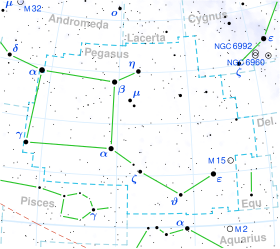Pi1 Pegasi
| Observation data Epoch J2000.0 Equinox J2000.0 | |
|---|---|
| Constellation | Pegasus |
| Right ascension | 22h 09m 13.61893s[1] |
| Declination | +33° 10′ 20.4778″[1] |
| Apparent magnitude (V) | +5.58[2] |
| Characteristics | |
| Spectral type | G8IIIb[3] |
| B−V color index | +0.985±0.003[2] |
| Astrometry | |
| Radial velocity (Rv) | +5.1±0.9[4] km/s |
| Proper motion (μ) | RA: −48.117[1] mas/yr Dec.: −73.408[1] mas/yr |
| Parallax (π) | 10.2111±0.1137 mas[1] |
| Distance | 319 ± 4 ly (98 ± 1 pc) |
| Absolute magnitude (MV) | 0.84[5] |
| Details | |
| Radius | 11.00+0.51 −0.83[1] R☉ |
| Luminosity | 62.8±0.8[1] L☉ |
| Surface gravity (log g) | 2.7[6] cgs |
| Temperature | 4,898+196 −110[1] K |
| Metallicity [Fe/H] | −0.22[5] dex |
| Rotational velocity (v sin i) | 4[6] km/s |
| Other designations | |
| π1 Peg, 27 Pegasi, BD+32°4349, HD 210354, HIP 109352, HR 8449, SAO 72064[7] | |
| Database references | |
| SIMBAD | data |
Pi1 Pegasi, Latinized from π1 Pegasi, is a star in the constellation Pegasus. Based upon changes to the proper motion of the visible component, this is a probable astrometric binary.[8] It has a yellow hue and is dimply visible to the naked eye with a combined apparent visual magnitude of +5.58.[2] The system is located approximately 319 light years distant from the Sun based on parallax,[1] and is drifting further away with a radial velocity of +5 km/s.[4]

The visible component is an aging giant star with a stellar classification of G8IIIb.[3] With the supply of hydrogen exhausted at its core, the star has cooled and expanded to 11 times the Sun's radius[1]. It is radiating 63 times the luminosity of the Sun from its enlarged photosphere at an effective temperature of 4,898 K.[1]
References
[edit]- ^ a b c d e f g h i j k Brown, A. G. A.; et al. (Gaia collaboration) (August 2018). "Gaia Data Release 2: Summary of the contents and survey properties". Astronomy & Astrophysics. 616. A1. arXiv:1804.09365. Bibcode:2018A&A...616A...1G. doi:10.1051/0004-6361/201833051. Gaia DR2 record for this source at VizieR.
- ^ a b c Anderson, E.; Francis, Ch. (2012), "XHIP: An extended hipparcos compilation", Astronomy Letters, 38 (5): 331, arXiv:1108.4971, Bibcode:2012AstL...38..331A, doi:10.1134/S1063773712050015, S2CID 119257644.
- ^ a b Abt, H. A. (September 1985), "Visual multiples. VIII. 1000 MK types", Astrophysical Journal Supplement Series, 59: 95–112, Bibcode:1985ApJS...59...95A, doi:10.1086/191064
- ^ a b Gontcharov, G. A. (November 2006), "Pulkovo Compilation of Radial Velocities for 35495 Hipparcos stars in a common system", Astronomy Letters, 32 (11): 759–771, arXiv:1606.08053, Bibcode:2006AstL...32..759G, doi:10.1134/S1063773706110065, S2CID 119231169.
- ^ a b Takeda, Yoichi; et al. (August 2008), "Stellar Parameters and Elemental Abundances of Late-G Giants", Publications of the Astronomical Society of Japan, 60 (4): 781–802, arXiv:0805.2434, Bibcode:2008PASJ...60..781T, doi:10.1093/pasj/60.4.781.
- ^ a b Massarotti, Alessandro; et al. (January 2008), "Rotational and Radial Velocities for a Sample of 761 HIPPARCOS Giants and the Role of Binarity", The Astronomical Journal, 135 (1): 209–231, Bibcode:2008AJ....135..209M, doi:10.1088/0004-6256/135/1/209, S2CID 121883397
- ^ "pi.01 Peg". SIMBAD. Centre de données astronomiques de Strasbourg. Retrieved 2025-09-12.
- ^ Eggleton, P. P.; Tokovinin, A. A. (September 2008), "A catalogue of multiplicity among bright stellar systems", Monthly Notices of the Royal Astronomical Society, 389 (2): 869–879, arXiv:0806.2878, Bibcode:2008MNRAS.389..869E, doi:10.1111/j.1365-2966.2008.13596.x, S2CID 14878976.
External links
[edit]- Kaler, James B., "Pi Pegasi", STARS.
